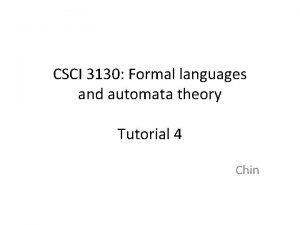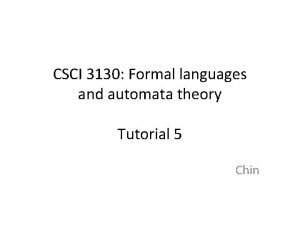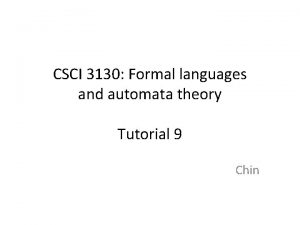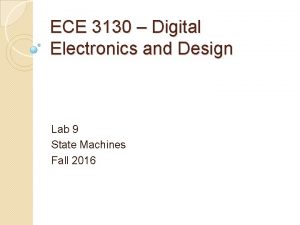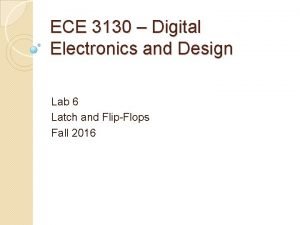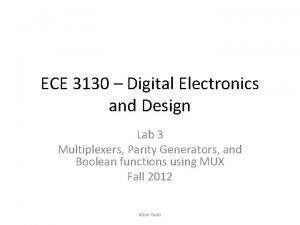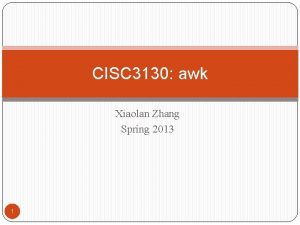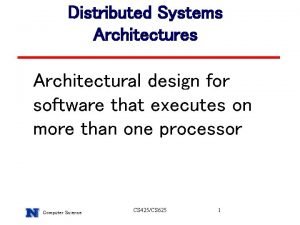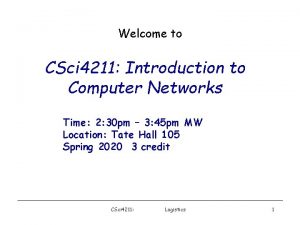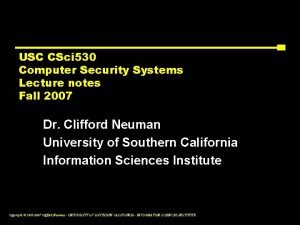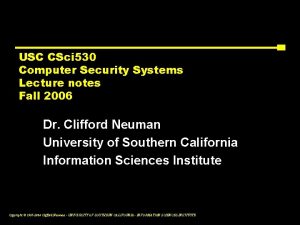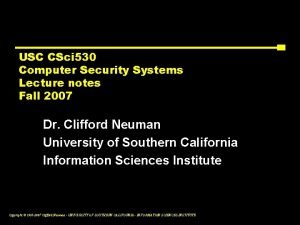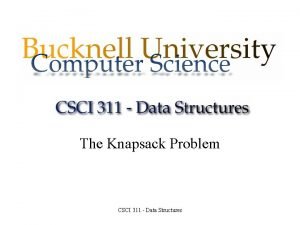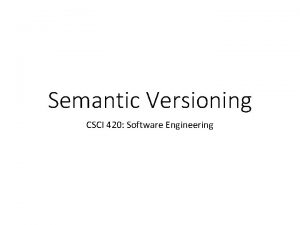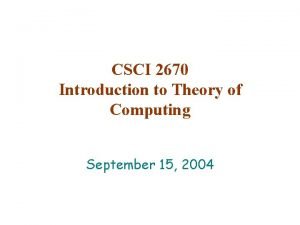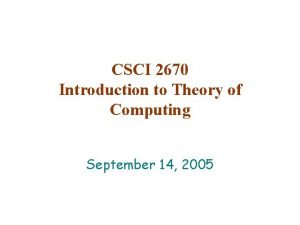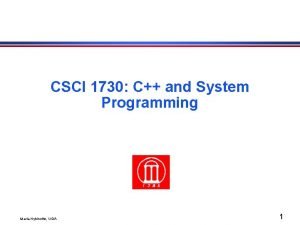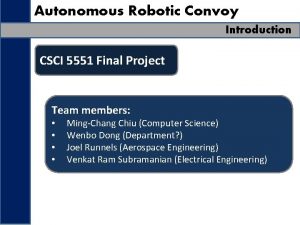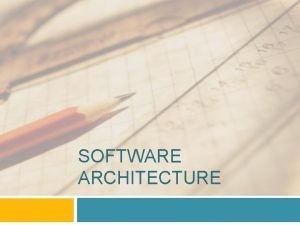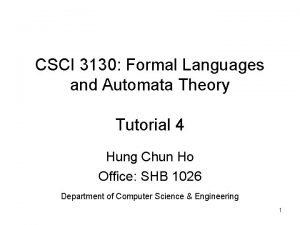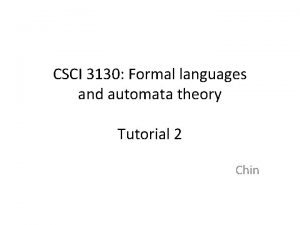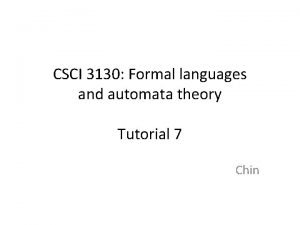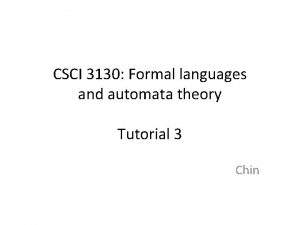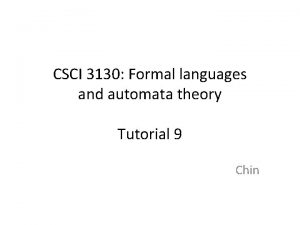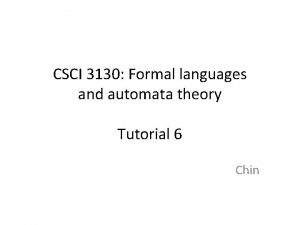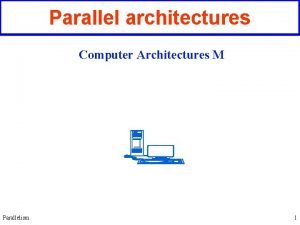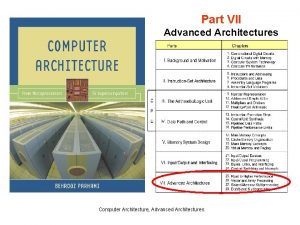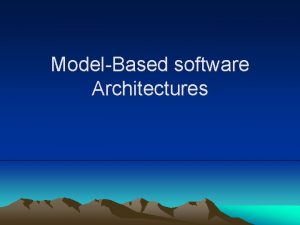CSci 3130 Software Architectures Software Architecture What is











































- Slides: 43

CSci 3130 Software Architectures

Software Architecture ● What is a Software Architecture? ● ● The description of the structure of a software system, which is composed of software elements, their externally visible properties and their relationships to each other. Software system design at the highest level. Closely related to Software Design – boundaries are very fuzzy. ● Iterative and incremental ● There is no one unique architecture for a given problem Why do we need it?

Understanding and Communicatio ● Software systems are too complex ● Abstraction of details ● ● ● Break a complex system into smaller, less complex sub-systems (Divide & Conquer) Individual sub-systems are better understood 50% of your time you deal with people who probably don't understand you.

Reuse ● ● Identifying the individual parts of the system facilitates encapsulation Encapsulation facilitates reuse ● ● ● Many small problems have been solved before Sub-systems are designed and implemented for a specific purpose / task with generalized interfaces Generalized interfaces allow the reuse of the same sub-system in a different complex system Software Product Lines The more reuse, the less money it costs, the safer your job

Construction and Evolution ● Individual sub-systems and well defined interfaces allow: ● ● ● Independent development of multiple sub-systems in parallel by different teams Independent testing of multiple sub-systems with much less test cases Replace one implementation of a sub-system with another implementation Easily estimate the impact of a change You won't get it right the first time → software evolves

Analysis ● Up-front analysis prevents undesired surprises: ● ● ● Design decisions Performance requirements Reliability Usability Does each sub-system satisfy its specific requirements? Under which conditions? ● ● ● Implementation restrictions Hardware Storage Interconnect Support

Software Architecture Models ● Various formal models / frameworks exist: ● ● ● Languages to describe the architecture: ● ● 4+1 RM-ODP SOMF IEEE 1471 -2000 – ISO/IEC 42010 -2007 (standards) Acme Wright UML Pick and choose

Architecture Views

Architecture Views ● ● ● Description of the architecture from different perspectives (viewpoints) Facilitates communication: ● Business Owner ● Client ● Software Designer ● Developer ● System Builder Everyone has their own vocabulary

View model or Viewpoints • A view is a representation of a whole system from the perspective of a related set of concerns • A view model or viewpoints framework define a coherent set of views to be used in the construction of a system architecture, software architecture, or enterprise architecture.

Example Views • Some examples of kinds of views (viewpoints in the 1471/42010 ontology) are: – Functional/logical viewpoint – Code/module viewpoint – Development/structural viewpoint – Concurrency/process/runtime/thread viewpoint – Physical/deployment/install viewpoint – User action/feedback viewpoint – Data view/data model

Types of Architecture Views ● Component & Connector View ● ● Module View ● ● Very universal, easy to understand, high-level Often the result of the software design Allocation ● Used by integrators and system engineers

Component & Connector View ● Graph-like diagram of the parts of a system and their relationships ● Parts = Components ● Relationships = Connectors

Component & Connector View

Components ● Units of computation or data storage ● Distinct names – Choose them wisely! ● ● ● Components have types, the C&C view shows specific instances Interfaces (ports) to communicate with other components Describe components independent of the system

Component Types

Connectors ● ● Connect components that interact with each other Distinct names – Choose them wisely! All communication between components is done through connectors – not only remote. Mechanisms: ● ● Function call RPC Broker-based Provided and implemented by middleware ● Beware: Easily slips into the component implementation!

Connectors ● Middleware connects components ● ● Different communication patterns and protocols ● ● ● ● Hardware (CPU instructions) OS infrastructure (pipes, shared-memory) Domain specific middleware (CORBA, HTTP, etc. ) Point-to-point Broadcast Multicast HTTP / REST CORBA (IIOP), SOAP AMQP Use different notation for different types of connectors

Connectors

Modular View • Often logical • Often combined with a component/ connector view • Can be a software design view

Allocation View • Describes the allocation of functional objects to computational components within the system, permits analysis of performance and used to verify satisfaction of requirements • Often used by integrators and system engineers

Data View • The data model • May be relational, may not

Example: Student Survey

Architecture Styles ● Design Patterns for Software Architectures ● Best practices to solve common problems ● Architecture is a combination of many ● Module View (Software Design): ● Decomposition ● Uses ● Generalization ● Layered

Examples of architectural styles and patterns • • • • • http: //en. wikipedia. org/wiki/Software_archite Blackboard Client–server model (2 -tier, n-tier, Peer-to-peer, cloud computing all use this model) Database-centric architecture (broad division can be made for programs which have database its center and applications which don't have to rely on databases, E. g. desktop application programs, utility programs etc. ) Distributed computing Event-driven architecture (Implicit invocation) Front end and back end Monolithic application Peer-to-peer Pipes and filters Plug-in (computing) Representational State Transfer Rule evaluation Search-oriented architecture Service-oriented architecture (A pure SOA implements a service for every data access point. ) Shared nothing architecture Software componentry Space based architecture Structured (Module-based but usually monolithic within modules)

Pipe & Filter ● Producer-consumer pattern ● Good encapsulation ● ● Asynchronous processing at each component Pipe connector responsible for synchronization Parallel processing (Map/Reduce) Document processing, signal processing, ETL

Shared-data ● Data repository + data accessors ● Communication through data repository ● Data repository responsible for data consistency and synchronization ● Add / remove components easily ● Passive / active data repositories ● Database applications, Web applications

Client-Server ● ● Client requests a response Response is generated by an action executed by the server ● Client waits for response ● Server itself might be a client ● Often stateless ● Client initiated ● Lightweight clients

Publish-Subscribe ● ● ● Producers publish messages on a shared medium (e. g. message bus) Consumers subscribe to certain types of messages Brokers may connect independent bus systems Scalable, transaction safe, easily extensible IRC, ESB, AMQP

Peer-to-Peer ● ● ● Like client-server, but every component is both client and server Intermediate components can act as proxies and/or caches Distribution of load Highly scalable for specific applications ICP, CDNs, Bit. Torrent, Gnutella, etc.

Discussion ● Architecture Integrity: ● ● Architecture Analysis: ● ● Why you should listen to the architect? What can you learn from an architecture? Architecture Documentation: ● How to communicate an architecture?

Architecture Integrity ● Why listen to the architect? ● ● Architecture imposes constraints Constraints allow to make assumptions in other parts of the system If the constraints are not respected, other parts of the system may no longer be compatible Deviation impacts communication, evolution, reuse, analysis

Example: Word Count Intended Architecture:

Example: Word Count Deviating Implementation 1:

Example: Word Count Deviating Implementation 2:

Architecture Documentation ● ● ● Diagrams are not sufficent documentation Documentation needs to satisfy all stakeholders Primary goal is to communicate the architecture: ● Structure and formulate the documentation with that in mind

Architecture Documentation Sample Outline: ● ● Context (diagram) ● How does the system fit into its environment? ● Who interacts with the system? Relevant Views (C&C, module, allocation) ● Diagram ● Describe the elements/components in the view in detail ● Describe the interfaces between elements/components ● Rationale for the decisions reflected in the architecture ● Describe behaviour and processes ● Combine views if suitable (e. g. C&C + allocation)

Architecture Documentation ● Formal languages: ● ● ● English works too Don't constrain yourself ● ● Acme Wright UML (good choice for diagrams) Use whatever gets the point across. Don't overload it ● One cloud is enough, and it does not need to be sparkly.

Architecture Analysis & Evaluation ● Significant impact on qualitative properties: ● ● ● More important than decisions at the implementation level: ● ● Performance Reliability Modifiability Portability A faster sorting algorithm only makes the chosen architecture faster, but not better. Evaluate an architecture w. r. t. individual properties

Architecture Analysis & Evaluation ● Formal simulation models can help: ● ● ● Difficult to capture all the information to have a representative model. Better choice for increasing system complexity (cost ↔ benefit) Alternative: Procedural Approach ● ● List attributes to be evaluated Assign an experience-based subjective assessment of the quality to each attribute (e. g. letter grades)

ATAM Architectural Tradeoff Analysis Method ● Developed by the Software Engineering Institute at the Carnegie Mellon University ● Goal: help choose a suitable architecture for a software system by discovering trade-offs and sensitivity points ● “Just” another semi formal inspection process. . .

ATAM Architectural Tradeoff Analysis Method 1. Collect Scenarios ● ● Use Cases, Error Cases, Exceptional Cases (e. g. high load) Attributes of interest 2. Collect Requirements and Constraints ● ● Check SRS for Qo. S requirements/expectations for each use case / attribute Find quantitative measures 3. Describe architectures that are subject to analysis 4. Analyze attributes w. r. t. Requirements 5. Identify Sensitivity and Tradeoffs ● ● Points with most significant impact when changes Impact on other components

What Viewpoints for Your Project? – Functional/logical viewpoint? – Code/module viewpoint? – Development/structural viewpoint? – Concurrency/process/runtime/thread viewpoint? – Physical/deployment/install viewpoint? – User action/feedback viewpoint? – Data view/data model?
 Formal languages and automata theory tutorial
Formal languages and automata theory tutorial Csci 3130
Csci 3130 Automata theory tutorial
Automata theory tutorial Csci 3130
Csci 3130 Pushdown automata
Pushdown automata Allcfg
Allcfg Heather lipford
Heather lipford Ece 3130
Ece 3130 Ece 3130
Ece 3130 Ece 3130
Ece 3130 Cisc 3130
Cisc 3130 Types of product architecture
Types of product architecture Database and storage architectures
Database and storage architectures Ansi/sparc
Ansi/sparc Switched backbone
Switched backbone Autoencoders, unsupervised learning, and deep architectures
Autoencoders, unsupervised learning, and deep architectures Scalable internet architectures
Scalable internet architectures Integral vs modular architecture
Integral vs modular architecture Gui architectures
Gui architectures Database system architectures
Database system architectures Cdn architectures
Cdn architectures Aaron bannert
Aaron bannert Two tier architecture of data warehouse
Two tier architecture of data warehouse What is isa computer architecture
What is isa computer architecture Website client server architecture
Website client server architecture Distributed systems architectures
Distributed systems architectures Backbone network architectures
Backbone network architectures Cache coherence for gpu architectures
Cache coherence for gpu architectures Why systolic architectures
Why systolic architectures What is architecture business cycle?
What is architecture business cycle? Call and return architecture
Call and return architecture Csci 4211
Csci 4211 Csci 530
Csci 530 Csci 530
Csci 530 Netcheque
Netcheque Csci 430
Csci 430 Csci 311
Csci 311 Csci 420
Csci 420 Csci 2720
Csci 2720 Csci 1951a
Csci 1951a Csci 2670
Csci 2670 Csci 2670
Csci 2670 Maria hybinette
Maria hybinette Csci 5551
Csci 5551



